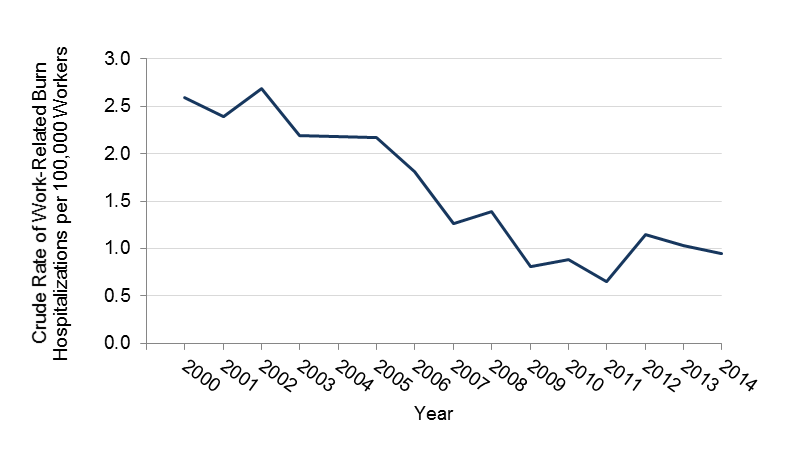Work-Related Burns Requiring Hospitalization
To track the incidence of hospitalizations for burns related to work activity, this indicator utilizes data from hospital discharge records.
Although work-related hospitalized burns are unusual events they are some of the most devastating, painful, and expensive injuries to treat. Many burns result in disfigurement, often leaving the individual unable to maintain their current position in the workforce. NIOSH estimated that there are 150,000 work-related burns treated in emergency rooms each year in the U.S. An estimated 30 to 40% of all burns are work-related, with younger people and males more frequently hurt. Development of new prevention methods for these injuries, as well as evaluation of new intervention measures, could be possible with the information gathered by this indicator.
Hospital discharge records include information on the payor(s) of the medical services and other costs. For this indicator, hospitalizations involving burns in which workers’ compensation is the payor are considered work-related. However, many work-related burns requiring hospitalization are not paid by workers’ compensation and would not be counted in this indicator. If a provider is unaware, or an employee fails to report that the injury occurred during a work-related activity, workers’ compensation would not be the payor. In addition, farmers, independent contractors, federal employees, longshoremen, and maritime workers are not eligible for state workers compensation. All of these factors will result in an undercounting of work-related burns that require hospitalization.
The numbers of work-related burns requiring hospitalization for both 2013 (29 cases) and 2014 (27 cases) were less then the yearly average during 2000-2014 (45 cases). In 2014 the average age of an individual suffering a work-related burn requiring hospitalization was 38 years of age. Approximately 92% of all work-related burn victims were male, a pattern consistent across all 15 years.
Number and Rate of Work-Related Burns Requiring Hospitalization in Minnesota (Age 16 or Greater), 2000-2014
| Year | Number | Rate per 100,000 employed persons ≥ 16 years of age |
| 2000 | 67 | 2.5 |
| 2001 | 65 | 2.4 |
| 2002 | 75 | 2.7 |
| 2003 | 61 | 2.2 |
| 2004 | 61 | 2.2 |
| 2005 | 61 | 2.2 |
| 2006 | 51 | 1.8 |
| 2007 | 35 | 1.3 |
| 2008 | 38 | 1.4 |
| 2009 | 22 | 0.8 |
| 2010 | 24 | 0.9 |
| 2011 | 18 | 0.7 |
| 2012 | 32 | 1.15 |
| 2013 | 29 | 1.03 |
| 2014 | 27 | 0.95 |
Crude Rate of Work-Related Burns Requiring Hospitalization per 100,000 Employed Persons (Age 16 or Greater), 2000-2014

Trend analysis of the number and rate of work-related burns requiring hospitalization from 2000 to 2014 depicts a statistically significant decreasing trend. Continued surveillance and prevention programs are necessary to further reduce the number of work-related burns. Unfortunately, an individual’s occupation is not consistently collected at the time of hospitalization making it difficult to identify at risk populations from this data source.